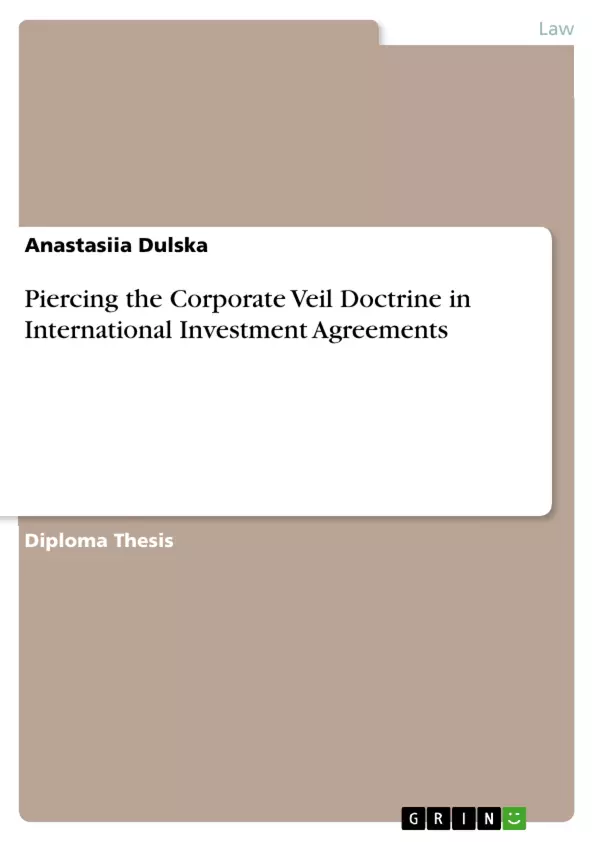The piercing the corporate veil in ISDS plays a twofold role. From the investors’ perspective, it is instrumental if a tribunal can ignore the difference between the legal personality of the company in which they invested in and the shares that they hold. Per contra, States also invoke this doctrine by trying to convince a tribunal to look at the true personalities involved and not to allow an investor to hide behind the veil of the different legal personalities.
To address these competing interests, the author of this Master Thesis in Chapter II intends to analyse the characteristic pattern and standing of shareholders in bringing indirect claims aimed to persuade the tribunal to ignore the difference between the legal personality of a company and its shareholders and to look at the true interests at stake instead. In Chapter III, the applicability of the piercing the corporate veil doctrine will be approached from the States’ perspective and when they invoke the denial of benefits clauses.
On the basis of the foregoing, this Master Thesis purports to address the intersection between the jurisdiction of the arbitral tribunal in ISDS and the concepts of investor and investment underlying the application of the piercing the corporate veil doctrine. By doing so, the author of this Master Thesis explores the provisions of IIAs commented on by authoritative treatises, contemporary views embodied in articles, and jurisprudence of international investment treaty tribunals. In order to arrive at its findings and conclusions, this Master Thesis utilizes the method of description, method of conceptual analysis, comparative method, and method of evaluation.
Inhaltsverzeichnis (Table of Contents)
- I. INTRODUCTION
- II. PIERCING THE CORPORATE VEIL FOR THE PURPOSES OF SHAREHOLDERS' INDIRECT CLAIMS
- A. PROVISIONS OF INTERNATIONAL INVESTMENT AGREEMENTS ON INDIRECT CLAIMS
- 1. Definition of “Investment” in IIA
- B. STANDING OF SHAREHOLDERS' ACTION FOR INDIRECT CLAIMS
- C. STANDING OF SHAREHOLDERS TO BRING INDIRECT CLAIMS IN INVESTMENT TREATY DISPUTES
- D. THE PROBLEM OF THE AUTONOMOUS NATURE OF SHAREHOLDERS' INDIRECT CLAIMS
- III. PIERCING THE CORPORATE VEIL FOR THE PURPOSES OF DENIAL OF BENEFITS CLAUSES
- A. DEFINITION OF NATIONALITY OF INVESTORS IN INTERNATIONAL INVESTMENT TREATIES
- B. DISREGARDING THE CORPORATE FORM IN DENIAL OF BENEFITS CLAUSES
- A. PROVISIONS OF INTERNATIONAL INVESTMENT AGREEMENTS ON INDIRECT CLAIMS
- IV. CONCLUSION
- ANNEX 1. Known treaty-based ISDS cases initiated in 2016 involving Ukraine
Zielsetzung und Themenschwerpunkte (Objectives and Key Themes)
This master thesis explores the application of the piercing the corporate veil doctrine within the framework of international investment agreements (IIAs). It examines the complexities of shareholders' indirect claims, the determination of investor nationality for the purpose of denial of benefits clauses, and the implications of piercing the corporate veil in these contexts.
- The definition of "investment" in IIAs and its relationship to shareholders' indirect claims.
- The standing of shareholders to bring claims under IIAs, considering the principles of separate legal personality and derivative rights.
- The application of the piercing the corporate veil doctrine in denial of benefits clauses, particularly in relation to investor nationality.
- The autonomous nature of shareholders' indirect claims and its implications for investment treaty disputes.
- The impact of the piercing the corporate veil doctrine on the effectiveness of international investment agreements.
Zusammenfassung der Kapitel (Chapter Summaries)
Chapter II delves into the complexities of shareholders' indirect claims in the context of IIAs. It analyzes the definition of "investment" under IIAs, the standing of shareholders to bring such claims, and the development of shareholders' rights in international investment law. This chapter also explores the concept of "foreign control" as a criterion for determining standing. Chapter III examines the application of the piercing the corporate veil doctrine in relation to denial of benefits clauses in IIAs. This chapter focuses on the determination of investor nationality, particularly in cases involving corporate structures and foreign control. It analyzes different scenarios where the corporate veil might be pierced, such as "A-B-A" and "A-B-C" scenarios.
Schlüsselwörter (Keywords)
The key terms and concepts examined in this thesis include international investment agreements (IIAs), piercing the corporate veil doctrine, shareholders' indirect claims, denial of benefits clauses, investor nationality, foreign control, corporate structure, separate legal personality, derivative rights, and investment treaty disputes.
- Quote paper
- Anastasiia Dulska (Author), 2017, Piercing the Corporate Veil Doctrine in International Investment Agreements, Munich, GRIN Verlag, https://www.grin.com/document/427445



